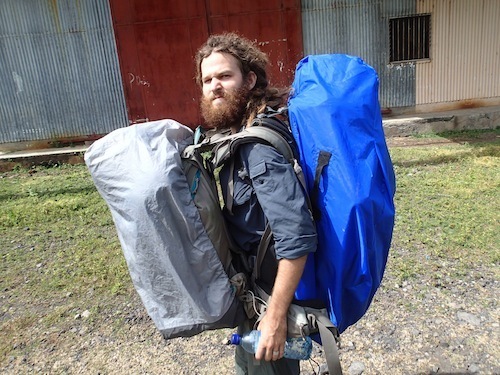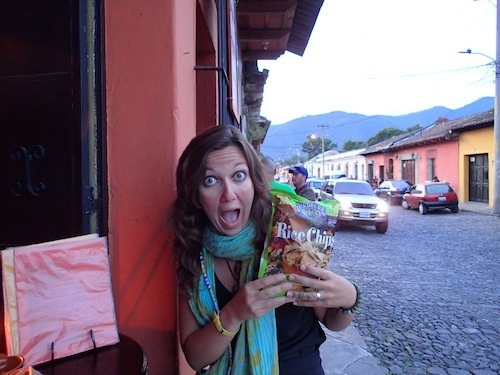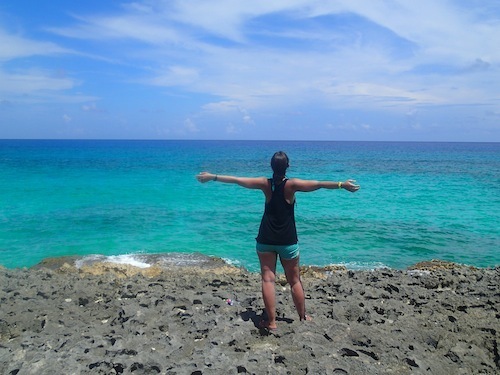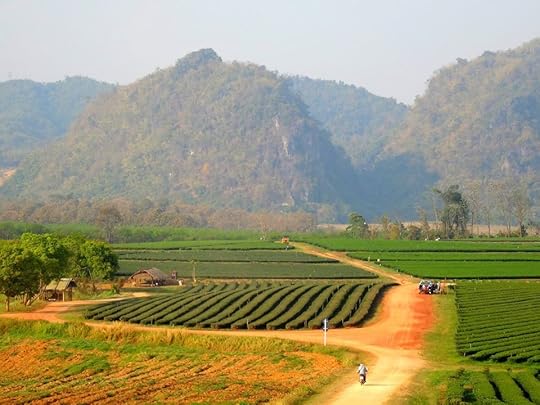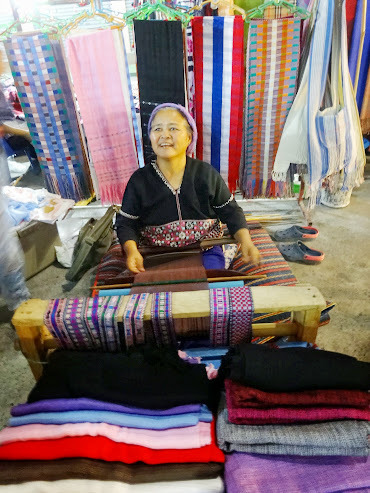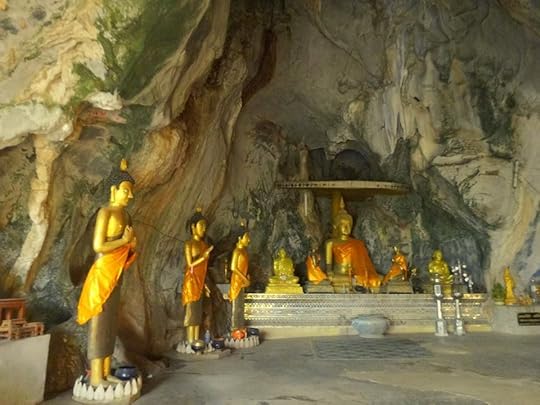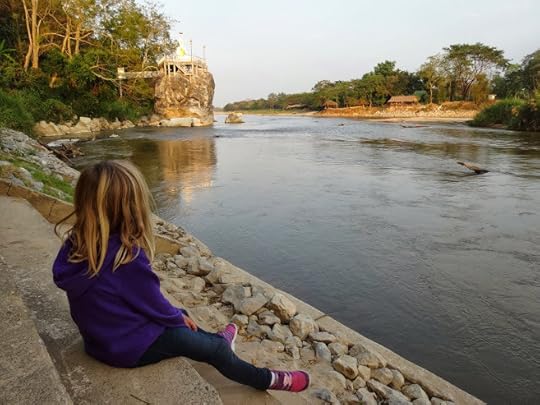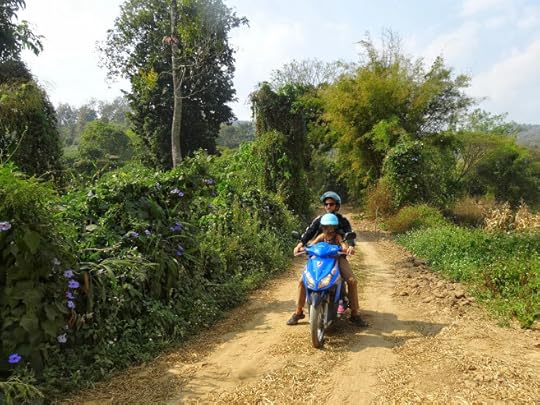Rolf Potts's Blog, page 44
April 6, 2014
The travel writer translates one culture for another
Vagablogging :: Rolf Potts Vagabonding Blog
“So it’s plain to see what responsibility lies with our work, reportage. Plying our trade, we are not just men or women of writing pursuits, but also some kind of missionaries, translators and messengers. We do not translate from one text into another, but from one culture into another in order to make them mutually better understood and thereby closer.”
–Ryszard Kapuscinski, “Herodotus and the Art of Noticing,” Lettre Ulysses Award Keynote Speech, October 4, 2003
Original article can be found here: The travel writer translates one culture for another
April 5, 2014
Review: Osprey Kestrel 48 backpack and how to choose a great backpack
Vagablogging :: Rolf Potts Vagabonding Blog
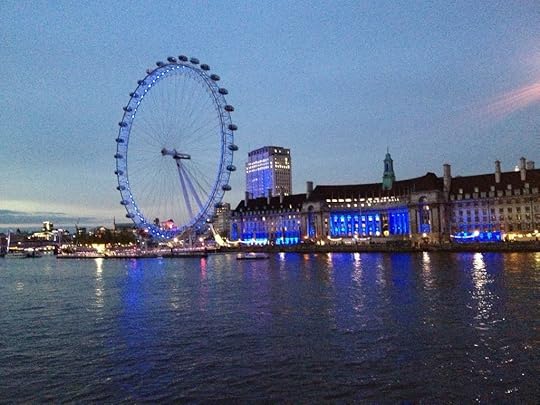
A good backpack can make or break a trip. Drenching rain, language barriers, delayed flights — you can weather all with humor and go-get-’em attitude.
But a good backpack is the foundation upon which your trip rests. It holds your entire life in one place. It protects it. Sometimes you wear it so often it feels like another appendage.
That’s why it’s important to take some time before your trip to figure out what kind of new appendage — or backpack — works for you. Next to figuring out which book to take with me, this decision was the most important on my two-week trip to Europe.
Review on Osprey Kestrel 48 backpack
 After lots of research, I decided on Osprey Packs Kestrel 48 backpack for three reasons:
After lots of research, I decided on Osprey Packs Kestrel 48 backpack for three reasons:
carrying capacity and size: airplane carry-on capable and men’s size fit my longer torso well;
price: $180 with a lifetime guarantee;
functionality: top-loading with sleeping bag compartment, integrated rain cover, and water-repellant fabric.
But the true test came after wearing my pack for two solid weeks. Included in that time were some very long midnight wanderings in suburban Rome searching for our hotel, running through train stations and for vaporettos, and getting shoved under train seats.
What I liked and disliked about the Osprey Kestrel
Liked:
The relative smallness of the pack. It was just large enough to cram in extra purchases made on the trip, but not too big I couldn’t shove it under the airplane seat on a budget Ryanair flight. Wearing it didn’t make me feel like I had strapped a minivan to my back.
All the straps. If need be, I could cinch the pack down to 2/3 of its original size.
Pockets galore: I love me lots of pockets. They help keep things organized and easily findable. Plus you never end up with dirty laundry cavorting with the clean.
Upper flap of the pack had a pocket for easy access to those things you always need quickly.
Access to the bag interior from the top and bottom: perfect for reaching everything in your pack without messing up the organizational system.
Made from 420D nylon packcloth: durable, water-repellant fabric. If it got too wet, enter the integrated rain cover that I could never leave behind.
The minimalist and stylish look. I picked the dark grey color with a red Osprey logo. Just subdued enough, it camouflaged dirt and didn’t look too expensive.
Lifetime toughness guarantee on all Osprey products for any damage or defect. Perfect.
Interior frame and hip belt with pockets. This hip belt was a lifesaver to relieve the pack’s weight off my shoulders.
Disliked:
How heavy my pack got at the end of the trip. But perhaps that’s my own fault.
If you crammed too much into the upper flap, it got difficult to close and cinch down.
The side pockets needed more closure than just wimpy elastic to prevent things from falling out.
What to look for when choosing a backpack
1. Functionality
How are you planning to use your pack? Will you be hiking or walking a lot? Do you need it to be water-repellant?
If you’ll be walking with it a lot, pick one with an interior frame and hip belt to redistribute the weight off your shoulders. Water-resistance is a good thing to consider, so check for a rain cover. You can’t always control the weather, but it’s nice to know your stuff won’t get soaked.
2. Durability
You want a pack that wears its age and travels well. You don’t want to deal with broken zippers or rips on the road.
Look for fabric at least 400 denier nylon packcloth with a urethane coating (aka water-repellant). Test the zippers. Do some Google searches on “broken zipper + pack name” to see how it stands up.
A good place to check out long-term durability is reading Amazon’s reviews on the pack; you get a wide smattering of opinions to help your decision.
3. Access into the bag
Do you want to access the bag just from the top (top-loading pack)? Or from the top and bottom (called the sleeping bag compartment)? Exterior pockets or no pockets?
These are things to consider if you want to lock your bag. The more access points into your bag equals more locks you need.
4. Carrying Capacity
Ah, the clincher. Getting a pack that’s too big will restrict your ability to carry it on the plane. Getting a pack too small will curtail your purchasing abilities.
It’s a really good idea to check out the bags in person. After all, this is gear that interacts with your body. Like shoes, how it feels on you will impact how you feel about the trip.
Play around with the packs. Try them on. Figure out how it feels on your back and do a few spins to check your bull in a china shop prowess. The empty pack should feel light and not too bulky on your back.
For me, the perfect capacity size was 48: still small enough for carry on, but large enough for clothes and extras picked up along the way.
5. Backpack size
Backpacks come in three sizes: small, medium and large. The sizes are determined by your torso length, not your height.
Here’s a general guide to figuring out the pack size from your torso length:
Men’s and Women’s
Pack Size
Torso Length
Extra small
Up to 15½”
Small
16″ to 17½”
Medium/Regular
18″ to 19½”
Large/Tall
20″+
Difference between men and women packs:
Generally, compared to men’s packs, women’s packs are:
a shorter torso range;
smaller carrying capacity;
the shoulder straps are narrower and shorter;
hip belts are shorter and may be contoured differently;
prettier.
But really, it comes down to how the pack feels on you. Even though I’m a woman, I picked a men’s pack based on how it fit me and what it looked like. Oh — and that it had good pockets.
Read more by Laura at Waiting To Be Read.
Original article can be found here: Review: Osprey Kestrel 48 backpack and how to choose a great backpack
April 4, 2014
Rolf Potts on Budget Travel
Vagablogging :: Rolf Potts Vagabonding Blog
Whenever anyone asks me why I still travel on a shoestring at the ripe old age of 38, I usually tell them about the time I learned how to play the bagpipes in Havana.
Granted, I could probably relate a more typical story about the joys of budget travel - some tidy parable of money saved and experiences gained – but when I mention learning the bagpipes in Cuba it sounds like I’m going to tell a joke, and people like jokes.
The thing is, there’s no punch line. My encounter with Cuban bagpipers wasn’t memorable for its mere quirkiness – it was memorable because it illustrates how travelling on the cheap can offer you windows into a culture that go beyond the caricatured stereotype of what a place is supposed to be like.
If it sounds to you like I’m an ageing backpacker who never quite grew out of his shoestring ways, you’d be exactly right. In many ways, my travel sensibilities have grown out of a journey I took 10 years ago, when I quit my job as an English teacher and took a journey across Asia, Eastern Europe and the Middle East. I probably had enough money saved up to invest in a three-month trip. As it turned out, I learned ways to stretch my travel budget into a life-enriching 30-month sojourn – and in all those months of travel, my day-to-day costs were significantly cheaper than day-to-day life would have cost me back in the United States.
The secret to my extraordinary thrift was neither secret nor extraordinary: like many generations of backpackers and shoestring travellers before me, I was able to make my modest savings last by slowing down and forgoing a few comforts as I travelled. Instead of luxury hotels, I slept in clean, basic hotels, hostels and guesthouses. Instead of dining at fancy restaurants, I ate food from street vendors and local cafeterias. Occasionally, I travelled on foot, slept out under the stars, and dined for free at the stubborn insistence of local hosts. In what eventually amounted to over two years of travel, my lodging averaged out to just under $5 a night, my meals cost well under $1 a plate, and my total expenses rarely exceeded $1,000 a month. Instead of investing my travel budget in luxuries and amenities, I invested it in more travel time – and it never failed to pay off in amazing experiences.
It’s been almost eight years now since I finished that extended stint of vagabonding, but the experience is still very much a part of me. In financial terms, I have the resources to sleep in five-star hotels and eat in expensive international restaurants, but I’ve found I rarely choose such luxurious options. Given a choice between a $400-a-night hotel and an $18-a-night flophouse in Hong Kong, I tend to opt for the latter. Faced with the prospect of an all-inclusive dinner buffet in a Santo Domingo casino, I invariably find myself wandering outside to sample food from street vendors.
Ultimately, the charm of budget travel has always been less about saving money than making the most of my time on the road. Travelling cheaply has forced me to be engaged and creative, rather than to throw money at my holidays and hope for the best. Freed from a rigid, expense-laden itinerary, I’m more likely to be spontaneous, embrace serendipity and enjoy each moment of my journey.
Excerpted from Around The World On a Shoestring-The Guardian Feb. 6, 2009
Original article can be found here: Rolf Potts on Budget Travel
Vagabonding Case Study: Caroline Eubanks
Vagablogging :: Rolf Potts Vagabonding Blog
Caroline Eubanks
Age: 25
Hometown: Atlanta, Georgia
Quote: “It’s okay to travel alone. I spent a lot of time with a group of people, but would have been much happier doing my own thing, going places I wanted to see and at my own pace, rather than following along with the group.”
How did you find out about Vagabonding, and how did you find it useful before and during the trip?
I bought my sister a copy of the book for Christmas a few years before my trip and got one for myself shortly after. I found myself constantly underlining and highlighting passages that I connected with. I then found the website, which was a community and resourves for like minded travelers.
How long were you on the road?
I traveled around Australia for a year on a working holiday visa.
Where did you go?
I covered most of Australia, including six months in Sydney, as well as visits to Melbourne, Adelaide, the Great Ocean Road, and Uluru. I also took a bus through the entire East Coast, with stops in Brisbane, Surfers Paradise, Cairns and the Great Barrier Reef.
What was your job or source of travel funding for this journey?
Before I left, I was working three part-time jobs, including retail and restaurant gigs. I was also doing some freelance writing work and earned a small amount from advertisements on my site. I also moved in with my family and cooked my own meals to cut costs.
Did you work or volunteer on the road?
The terms of my visa allowed me to work in one place for six months before finding another job for the next six months. I worked at a hotel bar and as banquet staff in Sydney for six months, which is how I saved for the future months of travel. I also filed my taxes before I left to go up the East Coast, so my tax return gave me a little extra cash.
Of all the places you visited, which was your favorite?
Nearly everywhere had different appeal. Sydney felt like home, so it will always be one of my favorite places, but there’s nothing quite like the Great Barrier Reef. It truly is great and feels like infinite blue once you’re out there. I spent a few days on a liveaboard dive boat and it wasn’t nearly enough.
Was there a place that was your least favorite, or most disappointing, or most challenging?
Fraser Island is one of the most hyped-up backpacker spots in Australia, a sand island in Queensland where you go driving in 4WDs, swim in clear blue lakes and look out for dingoes. But during my trip, it rained constantly and I got bit by sand flies. I’m not all that outdoorsy, so it wasn’t exactly my cup of tea.
Which travel gear proved most useful? Least useful?
My laptop has been essential for my travels, as I use it to write freelance articles and keep my family updated on my progress. I also use it to watch movies when I’m on long bus rides.
Most of my gear was used during the trip, but I didn’t end up wearing my grubby clothes and instead bought normal clothes to wear to work. But since I didn’t know what I would be doing or how long I would be staying, I didn’t know how to pack.
What are the rewards of the vagabonding lifestyle?
Each day can be different. You are always meeting new people, many of which share your values and priorities. It keeps you on your toes and pushes you outside of your comfort zone. I’m an introvert by nature, but the lifestyle makes me more outgoing.
What are the challenges and sacrifices of the vagabonding lifestyle?
I’ve found it challenging to find people who are a part of the vagabonding lifestyle as well. My friends at home don’t travel much and all have jobs and houses, so it can be hard to relate when I’m back at home. It also makes relationships difficult. You miss a lot while you’re on the road, like weddings and babies and promotions, but it’s a sacrifice you have to be willing to make. Only you can decide if it’s worth it.
What lessons did you learn on the road?
I was taught how much I can handle. Things that give me anxiety back home, like changes and problems, are easier to deal with on the road. I must think on my feet when it comes to missed buses and overbooked hostels.
How did your personal definition of “vagabonding” develop over the course of the trip?
How Rolf defines vagabonding in the book involves facing fears, learning about new places, and being open to what the world has to offer. I think my experiences have been very similar to his definition. Before the end of my trip, I’d gone bungy jumping over the rainforest, ridden a motorcycle through the Queensland bush and learned to scuba dive in the Great Barrier Reef, all things I never would have done before.
If there was one thing you could have told yourself before the trip, what would it be?
I would have told myself that it’s okay to travel alone. I spent a lot of time with a group of people, but would have been much happier doing my own thing, going places I wanted to see and at my own pace, rather than following along with the group. This was a trip I dreamed of for years, so I should have fought for my own itinerary.
Any advice or tips for someone hoping to embark on a similar adventure?
Save much more money than you think you’ll need. I was ill-prepared for the cost of everyday life in Australia and had to get a job much earlier than I anticipated. It’s better to have too much money than not enough. You want to enjoy your time there, not stress about how you’re going to stretch your money until dinner.
When and where do you think you’ll take your next long-term journey?
I’m leaving in a few weeks for three months. I’ll be returning to Australia to catch up with friends before jaunting around Southeast Asia and attending a friend’s wedding in Thailand.
Website: carolineinthecityblog.com
Twitter: cairinthecity
Are you a Vagabonding reader planning, in the middle of, or returning from a journey? Would you like your travel blog or website to be featured on Vagabonding Case Studies? If so, drop us a line at casestudies@vagabonding.net and tell us a little about yourself.
Original article can be found here: Vagabonding Case Study: Caroline Eubanks
April 2, 2014
“Real” travel and stereotypes
Vagablogging :: Rolf Potts Vagabonding Blog
There seems to be something of a competition amongst travelers. A battle over who gets to define travel and impose said definition on the rest of the traveling masses. What does “real” travel look like? What are travelers “supposed” to do? Say? Think? Believe?
Recently I was treated to a familiar speech. A long-term traveler, complete with guitar case, backpack full of patches, full beard, and rainbow colored hat, lamented about the “walking stereotypes” disembarking from boats headed for the all things New Age in San Marcos. He shifted into high gear as he bemoaned the sorry state of Western (i.e. US) culture and scoffed at the new arrivals’ clean, and obviously new, backpacks as if such a thing were a sign of a person who should not be allowed to travel anywhere, let alone Lake Atitlan. Outwardly, I neither agreed nor disagreed with his well-rehearsed monologue but I did have to stifle a smile as I noticed that my new friend, the one busy looking down on those newly arrived “walking stereotypes”, wasn’t wearing any shoes- the most obvious and often pointed out stereotype of gringos visiting San Marcos del lago.
We are all stereotypes, us traveling folk. Every single one of us. It’s likely that we fit the bill of any number of stereotypes before we even took off. Stereotypes exist in the eye of the beholder and we are always, all the time, doing something that fits perfectly into someone else’s stereotype of who we are or where we come from. And yet, for some reason, we insist on going to battle with each other, placing our own assumptions on other travelers, and perpetuating the notion of “us” and “them” within our own little traveling community.
You’ve only been traveling for 6 months? That’s nothing. You’re not “really” traveling until you hit 6 years.
Did you see what she’s wearing? Why would anyone wear that here? (laughs) She must be on spring break.
You brought how much luggage?? Why? I’m a traveler, not a tourist, so I can survive with just a towel and a clean pair of underwear.
Why are you saying “sorry”? Good God, you must be American. Western culture is just so full of guilt! Haven’t you figured out how to let that go yet? You’re in (insert developing nation here) now!
You can’t get mad at men for treating you poorly here. (snorts) This isn’t America.
You’re going to eat that?! You should just eat a tortilla. That’s what the locals do. But then again, I guess not everyone is a “real” traveler.
Here’s the thing- we’re all just trying to figure this shit out. Sometimes some of us are sick of tortillas and just want some damn french fries. It’s not meant to be an affront to other travelers or an invitation for everyone to chime in with their opinions on whether french fry eating automatically revokes one’s “real traveler” card or not. The french fries do not necessary represent Western dominance, lack of awareness over environmental issues, or “fake” vegetarianism. You know what they do represent? French fries. Delicious, hot french fries that taste just a little bit like home after a long day.
Not every single one of us is on the same place on the path. Sometimes we’re not even not the same path. Once in a while, we aren’t even headed to the same destination. The lesson I am supposed to learn in this lifetime, is likely not the lesson you are meant to learn. This just might mean that the way we go about doing things might, just maybe, be different.
I write a lot about the fact that there is no “us” and “them” in general. It may be time travelers internalize this same concept and apply it to their own unique, vagabond community. No more “us” and “them”. No more “real travelers.” No more judgment. You cannot stake your status as a “real” traveler by looking down your nose and smugly insulting others, even if they are “new.” Some travelers eat french fries- even in Nepal. Some have brand new, clean backpacks. They will get dusty and worn soon enough, there’s no need for others to rush it.
Every single one of us, whether on the road for a week, a year, or more is just traveling the path they were meant to travel. There is no such thing as “us” and “them”, whether we are talking about the street children of India or the traveler in the dorm bunk next to ours. Many of us offer grace, empathy, and at least an attempt to understand when engaging with people in the countries and cultures we are exploring- why not off the same to our fellow travelers?
Original article can be found here: “Real” travel and stereotypes
April 1, 2014
Vagabonding Field Report: Motorbike exploring outside of Chiang Rai, Thailand
Vagablogging :: Rolf Potts Vagabonding Blog
Cost/day:
$50-55/day
What’s the strangest thing you’ve seen lately?
Without question it is Wat Rong Kuhn, otherwise known as the White Wat. I read plenty about this wat, designed by Thai artist Chalermchai Kositpipat, and even saw dozens of pictures. Words and pictures alone did not prepare me for the grandeur, beauty and strangeness of this place.
Describe a typical day:
In the morning I work for a couple of hours and then we set out on the motorbike for the same place we go everyday for breakfast. We always change up where we eat lunch and dinner in a city, but once we find a good breakfast spot in town we seem to never deviate from it.
After breakfast we generally hop on the motorbike and go outside of town to places like a massive tea plantation, Buddhist caves, various wats, museums, waterfalls or hiking trails.
After our daily adventure we head back to the hotel for homeschool and to finish work for the day. We then go to the night bazaar where we see the various local and imported wares for sale, mostly to tourists.
For dinner we go to one of the many local stalls selling a type of broth soup that is cooked at your table in a clay pot with noodles, vegetables and meat.
Describe an interesting conversation you had with a local:
I found it interesting talking with the manager of the hotel about various locations to see outside of town. After going through her list of recommendations, I asked which were her absolute favorites. She answered that she had not been to any of them. When I asked her why she said she didn’t have time to go due to her work and family responsibilities.
It was humbling and a great reminder just how fortunate we are to travel and see sights that often many locals are not even able to see. It’s just another painful reminder how unfair the world is.
What do you like about where you are? Dislike?
I like the ability to quickly get outside of the town and see very beautiful sights. I like that the town and surrounding area are not overrun with tourists or owned and managed by tour agencies and large companies. It feels like the locals’ town.
I do not particularly like the town itself. There is not much about it that I find unique. Even this, though, has a type of charm when viewed through a certain lens. I would just advise renting some form of transportation when in Chiang Rai because the magic in this area lies just outside the city in the hills, caves, rivers and surrounding villages.
Describe a challenge you faced:
I got extremely sick due to questionable food while in a village outside of town. I have eaten unidentifiable street food from Istanbul to Bangkok without even a hint of stomach troubles, but I guess I was due. The worst part was that we had to take a bus for six hours the next day. This experience will not soon be forgotten.
What new lesson did you learn?
I was reminded that I tremendously enjoy having my own transportation, even it it’s just a 110 cc motorbike. Being able to get off the tourist trail and stop where we want has given us some of our most memorable and enjoyable moments. Simple things like finding a game of sepak takraw outside of town was just an unforgettable moment and really allowed us to see the daily life of the locals, something we always seek out.
Where next?
Luang Namtha, Laos for hiking and kayaking.
Original article can be found here: Vagabonding Field Report: Motorbike exploring outside of Chiang Rai, Thailand
March 31, 2014
Saskia: On Vagabonding & thanks to Rolf
Vagablogging :: Rolf Potts Vagabonding Blog
Last weekend I was in NYC, meeting with Rolf, among other things. It was mentioned, in passing, to a girl I met over dinner one evening and she got so excited: “I’ve read his book!! It literally changed my life!” She gushed. Her enthusiasm for travel was palpable, and she agreed to let me film her talking a bit about what the book, Vagabonding, had meant to her… she also had something to say to Rolf, personally:
Would you like to contribute a video about what Vagabonding has meant to you? Contact me: jenn(AT)vagabonding.net
Original article can be found here: Saskia: On Vagabonding & thanks to Rolf
March 30, 2014
You have to get off the paved road to see where you are
Vagablogging :: Rolf Potts Vagabonding Blog
“We all know that it’s possible to drive from here to California and stay at more or less the same motel the entire way, in a landscape where certain elements never change. This might have been an interesting experience thirty years ago when it was still new. It might be an interesting experience is you were V.S Naipaul just arrived here from England. But basically it’s a challenge to one’s powers of describing the humdrum. On the Great Plains — and I’m sure in the rest of America as well — you have to get off the paved road if you want to see where you are.”
Ian Frazier, in They Went: The Art and Craft of Travel Writing (1991)
(1991)
Original article can be found here: You have to get off the paved road to see where you are
Travel writing today and yesterday: an interview with Kent Davis of DatAsia Press
Vagablogging :: Rolf Potts Vagabonding Blog
Sometimes I wonder if modern travel writing still has anything fresh to say, and I can’t really find a satisfactory answer.
This question became much more pressing after I discovered an American publisher who reprints old travel writing gems from early 20th century’s Asia. I’m talking about DatAsia press, based in Florida.
 They have just re-released Harry Hervey’s two early travel accounts of French Indochina (which we use to call Southeast Asia, today), King Cobra and Congai. They are the first ever accounts of an American traveler in the region at the end of the 1920s. Only in his mid 20’s, brave Texan Hervey stormed off to Indochina and captured his first impressions by penning down these two sultry, fictionalized accounts of a place we have now lost in time.
They have just re-released Harry Hervey’s two early travel accounts of French Indochina (which we use to call Southeast Asia, today), King Cobra and Congai. They are the first ever accounts of an American traveler in the region at the end of the 1920s. Only in his mid 20’s, brave Texan Hervey stormed off to Indochina and captured his first impressions by penning down these two sultry, fictionalized accounts of a place we have now lost in time.
Pico Iyer, one of the greatest living travel writers, introduces King Cobra with great emphasis: “Great travel books give you journeys from which the traveler (perhaps the reader) comes back transformed, a mystery to himself. Suddenly you can no longer trust what you knew so firmly a day ago; suddenly all sense of “home” and “abroad” — of “you” and “I” — dissolves. A real trip turns you around so that you leave behind the person you were and maybe the one you wanted to become. Hervey may have embellished his real experiences, and drawn liberally from the books that fired his imagination before he left home — as Marco Polo and Ibn Battuta and Bruce Cahtwin did.”
I decided to reach out to Kent Davis, owner of DatAsia press, to ask him a few exclusive questions for all those Vagabonding readers who are –or are dreaming of – honing the travel writing craft. Kent has definitely a few opinions that will help your quest to understand more about this difficult craft, and will explain how he decided to look back, instead of publishing anything contemporary.
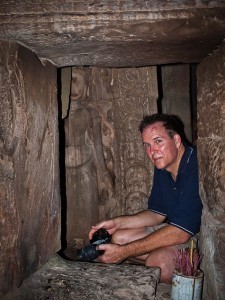 How did the DatAsia venture came about, and what is your main publishing goal?
How did the DatAsia venture came about, and what is your main publishing goal?
In 2005, my wife and I founded DatAsia as an independent press. Our mission is to publish rare books about Southeast Asian history and culture, with a special focus on topics relating to women. In addition to sharing previously unpublished research, we are also devoted to reviving obscure histories that have long gone out of print and been forgotten. Another aspect of this is translating selected works into English for the first time. In many ways, we have become “literary archaeologists.”
You just released two books by Harry Hervey, one of the first voices to write about early 20th century Indochina. Why this choice?
Hervey was a visionary writer with great observational and intuitive skills. But what makes Hervey especially unique is that he was an American writer in Southeast Asia, writing about this exotic outpost of the French colonial empire from that perspective.
In light of present world politics, it’s important to be clear that Hervey saw America and its ideals of democracy quite optimistically, as fit the times. In the early 20th century, Hervey observed, and questioned, the politics of colonialism, sexuality, exploitation and racism while observing the extraordinary experiment that mixed the races of East and West in French Indochina.

In King Cobra, he gives us a readable travelogue with adventures that, for the most part, can still be experienced today. Despite being a fictional novel, I think that he gives us even more truth in Congai, his tale of a Eurasian woman who becomes the mistress to a series of Frenchmen.
Pico Iyer, an esteemed travel writer, wrote the introduction to both Hervey’s books you published. Why did you ask him, and how do you see this legacy of early and contemporary travel writers continuing a discourse?
I’ve admired Pico’s writing since reading Video Nights in Kathmandu back in 1990, concurrent with my own first travels in Asia. Pico has that magical knack for expressing what is going on deep beneath the surface of other cultures. It’s a wonderful gift. He and I exchanged a few letters over the years and when I learned that he had never read either of Hervey’s books I sent him my originals. He was stimulated by what he read and I knew he was the perfect person to comment on Hervey’s works.
Ultimately, Pico helped me to understand just how talented and prescient Hervey was in his documentation of Asia. Last summer he agreed to write an original foreword for each book. His articles really put the author and his works in perspective and answer your question far better than I can. Both Pico’s unabridged forewords are available at the links below:
King Cobra, “The Lure of Hidden Treasure”
Congai, “The Book That Launched a Thousand Ships”
How do you think Hervey’s writing is still relevant today?
Two things immediately come to mind.
First, new visitors to Southeast Asia will be surprised by how much the culture, the experiences, the social interactions and the mysteries are still intact. Yes, there’s more technology now, we live in a “global village,” but the essence of what he saw is timeless and his impressions are still very valid.
Second, the issues he addressed also remain a part of everyday life, not just in Southeast Asia but around the world. Racism, sexual discrimination, subjugating populations with force, surviving in a hostile world, economic exploitation…all, sadly, still a big part of the human experience. But Hervey’s views weren’t all negative. He also optimistically captures the elation of intercultural travel…a thrill that your readers embrace today.
Some of Vagabonding’s readers are aspiring travel writers. I’m sure that it could be useful to have some comments from the other side of the publishing trench. How do you see the industry today, and especially travel writing?
 Digital media has changed everything for the better. Books and blogs like Vagabonding have empowered every traveler to have his or her own adventures, and to share them with others. I’m frequently amazed by detailed traveler accounts about destinations that I myself dream of visiting. Print books have always allowed armchair travelers to experience remote corners of the world through words. Now, the Internet lets us see and experience these places with a level of detail only limited by the imagination and technical skills of travelers posting their accounts.
Digital media has changed everything for the better. Books and blogs like Vagabonding have empowered every traveler to have his or her own adventures, and to share them with others. I’m frequently amazed by detailed traveler accounts about destinations that I myself dream of visiting. Print books have always allowed armchair travelers to experience remote corners of the world through words. Now, the Internet lets us see and experience these places with a level of detail only limited by the imagination and technical skills of travelers posting their accounts.
I’m a bit of a dinosaur in that I still like print books, but I’m working hard to learn how to create digital content by enjoying the creativity of young guys like you. Economically, of course, we both face the challenge of surviving long enough to share our travel visions. Not many people read books, fewer still buy them, and on the web most information is available for free. The driving forces are our passions for discovery and sharing…and if we share the right stories, there may even be some modest compensation involved. Fingers crossed!
If you were to publish modern Asian travel writing, what would you be looking for in a manuscript?
In one of the appendices of Congai, I quote Hervey having this amusing exchange with a Frenchman in Phnom Penh in 1925:
“You are a tourist,” he said; and it was not even a question.
“I replied that I was a writer; for, aside from my perfectly healthy dislike for the word tourist applied to me, it would be technically incorrect because a tourist, in spite of popular opinion, travels to tell other countries about his own”
What journalist doesn’t bristle at being called a mere tourist? The journalist’s rarefied role is to penetrate the Zeitgeist, whereas, with few exceptions, tourists see what they are supposed to see and go where they are supposed to go. Tourists visit the same predictable sites that—through years of refinement —governments and businesses have carefully packaged for financial gain and the burnishing of national images. Short-term visitors hardly get a chance to experience local ways of life or sample local ideas. Indeed, such things are downright inconvenient, especially when language barriers and time constraints stand in the way.
Harry Hervey quite literally strayed far from the beaten path to interact with natives and colonial residents alike. So the best advice I can offer is…don’t be a tourist.
MARCO FERRARESE is a metalpunk guitarist who travelled extensively and lived in Italy, the United States, China, Australia and Malaysia. Since 2009 he’s been based in Southeast Asia as a writer, hardcore punk musician and researcher. He travelled from Mongolia to Australia in 2009, and hitchhiked from Singapore to Milano through Silk Road routes and the Middle East in 2012. He blogs at monkeyrockworld.com. Marco’s first Asian pulp novel Nazi Goreng was published in November 2013 on Monsoon Books. Follow him @monkeyrockworld
Original article can be found here: Travel writing today and yesterday: an interview with Kent Davis of DatAsia Press
March 28, 2014
Perspective: The road’s gift
Vagablogging :: Rolf Potts Vagabonding Blog
“No journey is too great, if you find what you seek” – Anonymous
When I was little, I met counselors from all over the world at sleep-away camp. If you told me the ten year old who acquired a koala singlet from her counselor, would later marry an Australian and live down under; I would have told you, ‘you’re nuts’!
The travel bug bit hard during my first non-family trip. After university, a backpacking journey kept hold. Not far from the traditional American story there was college, graduate school and then a job. As a teacher, I traveled on every break and worked every summer at camp. The world continued to spin on its axis and adult life, as I knew it, was underway.
Meeting my husband on a trip in New Zealand changed everything. Relationships take work (especially long distance ones) and breaks now included international travel finding a spot between Australia and America. After many kilometers (and large phone bills), we married in 2009 and decided to go on a one-year adventure to follow the sun. Bucking tradition of everything I knew, we leapt and had no idea if any net would appear.
Travel lesson #1: I realized, my husband is my net…and gives me the strength to be my own.
That year, everything changed. I could tell you about the adventures, the people, and the sights, but that’s for another time. Most importantly, the vagabonding experience transformed me. It didn’t happen overnight. Sometimes a whisper, while at other times change screamed loudly. Fears packed in luggage were left behind along the way leaving me lighter in personal and tangible baggage. Certainties that allowed me to go were dropped out of airplanes unnecessary upon return. Vagabonding’s gifts are long lasting and perspective changing.
Travel lesson #2: People change but true friends will always be there.
We knew that the two of us could manage distance, but we didn’t know if our ‘home’ friends could. Those who truly wanted us in their lives did make the effort. Staying in touch mattered. We found that the more we traveled, the more like-minded individuals we met. We embraced and befriended locals. We felt a kinship with those who found that the more they explored, the longer their ‘list’. We learned that no matter where in the world, we were lucky to have close friends.
Travel lesson #3: Comfort Zones: Love ‘em and leave ‘em.
Comfort zones are never easy to leave, but more growth happens outside rather than in them. Like it or not, travel forces you outside of your comfort zone. For me, that was change, but the greater gift was realizing what to do with those newfound feelings is what truly matters. The more you venture outside of your ‘zone’, the more the comfortable one swells. Before we left, the uncertainties were frightening. The leave of absence and keeping the apartment minimized risk and allowed me to jump. How did I know if I was going to enjoy this travel/expat life or not? It was scary, yet exciting.
Somewhere along the line, my comfort zone expanded. Maybe it happened when we literally leapt off the edge of Devil’s Pool in Zambia. Maybe it was getting sick on a trip having to use our travel insurance to find a doctor. Maybe it was the search for a new dentist in Melbourne, bush-camping in Botswana or learning to dance in the rain. Little by little, the bigger picture mattered more. Once anxiety producing experiences became a welcome challenge. If I could write Travel her very own thank you card, I would. Foods I never would have tried, places I never thought to visit and communities I didn’t know existed provided direction, and a door to the outside of my comfort zone. Once outside, I couldn’t go back in.
Travel Lesson #4: Perspective-a traveler’s gift.
Tolerance should be taught, practiced and shared
Believe in yourself (even when you go against the norm)
Defy stereotypes at every opportunity
Flexibility, a positive attitude and patience can change any situation
Find your own balance
You are part of a much bigger world-try to make a positive difference each day
Listen, learn, smile, experience, and wonder-dream big!
There’s more than one way to live, teach, learn & do-choose your own path
Change is necessary and shows growth-don’t fear it
Health, love, laughter, friendship & dreams-most of what you ‘need’ in life could easily fit in a backpack
Travel Lesson #5: Lessons from the road.
Anywhere is walking distance if you have the time
Believe in yourself
Life is short; do what you love
Take pictures and leave only footprints!
1st world problems might be annoying, but someone else is often having a greater struggle; find perspective
It’s been almost four years since we returned from our first venture in ‘round the world travel. Since then, we’ve continued to travel, been touched by a natural disaster and thought a lot about the type of life we want. We relish knowing we are part of a bigger world and are grateful to have both roots and wings. Last year, we took a second ‘round the world trip (three months) seeing more of the world and interacting with new and interesting people. I took another leave and Mathew quit his job for that journey. We were less bothered by the risk. Change continued. Eventually, I resigned from the very structured world of public education and have found a new freelance career. It’s risky, but; I jumped. Maybe we’ll even take the leap to location-independent one day. Regardless of choice, it’s worth the chance to bring out our happy more often than not.
Travel, has been the gift that keeps on giving. It’s how we met and how we experience life. We don’t want to ‘get it out of our system’. We embrace the itch. Travel opened our eyes to what is out there and has given us the courage to take risks to live the life we imagine. The road provided an incredible gift…perspective. Now, there’s no turning back.
“Fate is what happens to you…destiny is what you do with it”
– Best Exotic Marigold Hotel
Read more by Stacey at the gift of travel
Original article can be found here: Perspective: The road’s gift
Rolf Potts's Blog
- Rolf Potts's profile
- 323 followers




